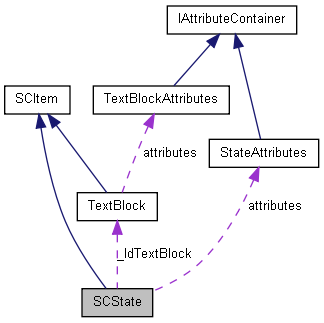The class represents a state in a state-chart Data-Model. More...
#include <scstate.h>
Inherits SCItem.
Collaboration diagram for SCState:

Signals | |
| void | changed () |
Public Member Functions | |
| SCState (QObject *parent=0) | |
| SCState (const SCState &st) | |
| SCState (bool topState=false) | |
| ~SCState () | |
| virtual IAttributeContainer * | getAttributes () |
| void | setStateName (QString n) |
| void | addTransistion (SCTransition *) |
| void | addState (SCState *) |
| void | setAttributeValue (QString key, QString value) |
| QString | getAttributeValue (QString key) |
| int | getStateCount () |
| void | setSize (QPointF &size) |
| void | setSize (QPoint &size) |
| void | setPosition (QPointF &size) |
| void | getAllTransitions (QList< SCTransition * > &list) |
| void | getTransitions (QList< SCTransition * > &transitionList) |
| void | getStates (QList< SCState * > &stateList) |
| void | getAllStates (QList< SCState * > &stateList) |
| void | writeSCVXML (QXmlStreamWriter &xmlWriter) |
| TextBlock * | getIDTextBlock () |
| Returns a pointer to the ID TextBlock. | |
Public Attributes | |
| StateAttributes | attributes |
Detailed Description
The class represents a state in a state-chart Data-Model.
The state contains children elements which are sub-states (also instances of SCState) and state-transitions (SCTransition class). The state also contains a public attribute container as well as convenience methods to accessing the attributes. Since te attribute container is public, attributes can be accessed directly.
The children states and transitions are contained as QObject children in the base QObject class (see addState or addTransition methods).
Constructor & Destructor Documentation
| SCState::SCState | ( | QObject * | parent = 0 |
) |
| SCState::SCState | ( | const SCState & | st | ) |
| SCState::SCState | ( | bool | topState = false |
) |
Here is the call graph for this function:

| SCState::~SCState | ( | ) |
Member Function Documentation
| void SCState::addState | ( | SCState * | s | ) |
Here is the call graph for this function:

| void SCState::addTransistion | ( | SCTransition * | t | ) |
Here is the call graph for this function:

| void SCState::changed | ( | ) | [signal] |
Here is the caller graph for this function:

| void SCState::getAllStates | ( | QList< SCState * > & | stateList | ) |
Here is the call graph for this function:

Here is the caller graph for this function:

| void SCState::getAllTransitions | ( | QList< SCTransition * > & | list | ) |
Here is the call graph for this function:

Here is the caller graph for this function:

| IAttributeContainer * SCState::getAttributes | ( | ) | [virtual] |
Implements SCItem.
| QString SCState::getAttributeValue | ( | QString | key | ) |
Here is the call graph for this function:

| SCState::getIDTextBlock | ( | ) |
Returns a pointer to the ID TextBlock.
- Parameters:
-
xmlWriter is the writer that writes the xml
| int SCState::getStateCount | ( | ) |
Here is the call graph for this function:

| void SCState::getStates | ( | QList< SCState * > & | stateList | ) |
Here is the caller graph for this function:

| void SCState::getTransitions | ( | QList< SCTransition * > & | transitionList | ) |
| void SCState::setAttributeValue | ( | QString | key, | |
| QString | value | |||
| ) |
Here is the call graph for this function:

| void SCState::setPosition | ( | QPointF & | size | ) |
Here is the call graph for this function:

| void SCState::setSize | ( | QPointF & | size | ) |
Here is the call graph for this function:

Here is the caller graph for this function:

| void SCState::setSize | ( | QPoint & | size | ) |
Here is the call graph for this function:

| void SCState::setStateName | ( | QString | n | ) |
Here is the caller graph for this function:

| void SCState::writeSCVXML | ( | QXmlStreamWriter & | xmlWriter | ) |
Here is the call graph for this function:

Here is the caller graph for this function:

Member Data Documentation
The documentation for this class was generated from the following files:
- C:/Users/David/Documents/QtProjects/visualsc/scdatamodel/scstate.h
- C:/Users/David/Documents/QtProjects/visualsc/bin/debug/moc_scstate.cpp
- C:/Users/David/Documents/QtProjects/visualsc/scdatamodel/scstate.cpp
 1.7.1
1.7.1